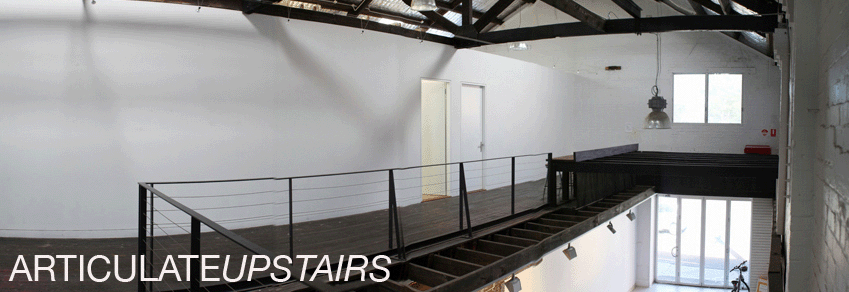Open 11am - 5pm Friday - Saturday 7 - 15 April 2018
From one side of the
wall to the other shows works by three of the artists with studios behind
the ArticulateUpstairs walls, who are
each moving some of their works from one side of the wall to the other.
 |
| Photo: Peter Murphy |
Tim Bass is moving a selection from his recent paintings. Sue Callanan is re-locating her cork bricks to reflect the form
and orientation of the building. Margaret Roberts is re-arranging her Richard
Artschwager blps to re-signal the
world around us.
 |
| Tim Bass ‘Untitled’, 2012, Oil on canvas |
I’ve used cork bricks to
displace familiar readings of the present architectural form of the building.
The ‘bricks’ align in a pattern that is mirrored on both vertical and
horizontal planes, signalling the orientation of the building and referencing
various ‘discrete’ architectural elements—the apex of the ceiling, the stepped
brick corbels, open louvre windows. The unlikely material form of the ‘bricks’
is located in such a way as to also draw attention to the particular surface
textures—existing bricks and timber and, by extrapolation, other architectural
forma and materials within the building.
 |
| Margaret Roberts blp 2018 wood, paint, boot polish, location. Ph Peter Murphy |
I have installed two blps as part of my regard
for artists who make physical space a key subject of their work. Why did that suddenly become so popular
among artists last century? Was it in the hope that people would mimic the work
and start noticing the world around them as well? Did they think the abuse of
the environment might stop if enough people started also valuing the physical places
in which they lived? Did they dare to hope that enough people might start
caring for the physical places in which we live to stop fossil fuel burning, coal
mining and csg fracking, to close nuclear power stations before they leaked into
the oceans, to stop using plastic, to prevent global warming, to plant trees
everywhere, and so on? Imagine the
future we would be facing now if that had actually happened in the twentieth
century?
Those twentieth century artists are not to blame
for that failure any more than the many others who contribute to the world-wide
environmental movement that keeps battling in the hope that the worst can be
avoided. Richard Artschwager was
one of those many twentieth century artists. He made blps (among other things) from the mid 1960s
onwards: curator Jennifer Gross described a blp as something that ‘had no
merits unto itself, but you would notice the context, the world around it, . .
. it is a signal for you to see other things’ (1). While the name blp is unique to Artschwager, the shape
itself is everywhere—look for it on footpaths, in your kitchen and pill packets,
in building decorations left from ancient Rome, the Baroque and probably other periods. margaretroberts.org
(1) youtube.com/watch?v=ELIo2zY2AQw
(1) youtube.com/watch?v=ELIo2zY2AQw

